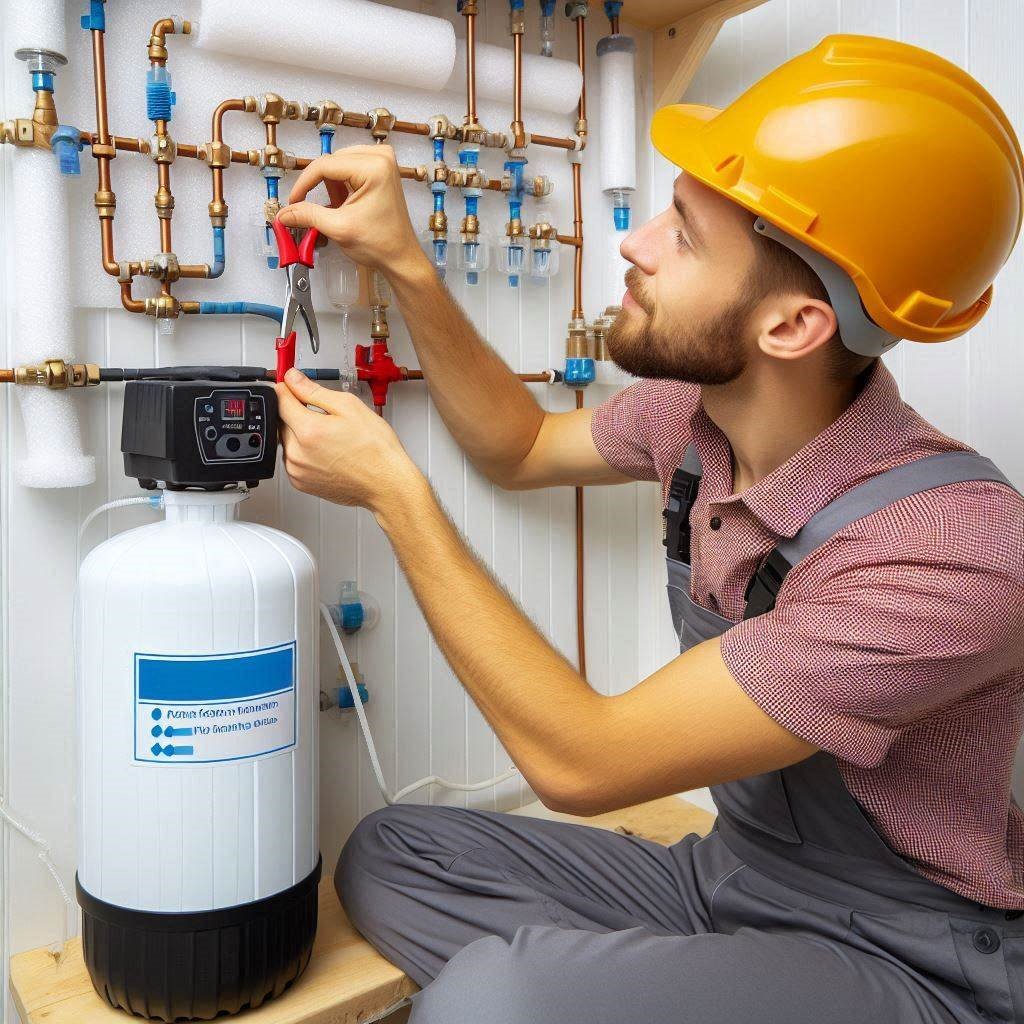Pre-plumbing for a water softener involves setting up the necessary plumbing connections during a home’s construction or renovation to accommodate a water softener. This proactive approach offers several benefits, including easier installation, cost savings, and an optimized setup that ensures the water softener functions efficiently. Installing a water softener on pre-plumbed lines typically involves connecting the unit to the pre-existing water loop, drain, and electrical outlet, making the process straightforward and less time-consuming.
Table of Contents
TogglePre-Plumbing for Water Softeners
A pre-plumbed setup for a water softener generally includes a dedicated water loop, a nearby drain access, and an electrical outlet. The water loop is a section of the main water line that is designed to allow easy installation of a water softener, often located near the main water shut-off valve. The drain access is necessary for discharging the brine solution during the regeneration cycle, while the electrical outlet powers the water softener unit.
The advantages of having a home pre-plumbed for a water softener are numerous. First, it simplifies the installation process, as the necessary connections are already in place. This can result in significant cost savings, as less labor and fewer materials are needed. Additionally, a pre-plumbed setup is typically optimized for the most efficient operation of the water softener, ensuring that the unit is installed in the best possible location for maximum performance.
However, not all pre-plumbed setups are created equal. The placement of the components—such as the water loop, drain, and electrical outlet—can greatly affect the ease of installation and the efficiency of the water softener. It’s important to assess your pre-plumbed setup carefully to ensure it meets the requirements for a water softener installation.
Assessing Your Pre-Plumbed Setup
Before installing a water softener, it’s essential to evaluate your pre-plumbed setup. Start by locating the water softener loop and ensuring it is easily accessible. The loop should be positioned in a location that allows for convenient access to the main water line and other necessary connections.
Next, check for a nearby drain access point, such as a floor drain, utility sink, or cleanout. The drain should be close enough to the water softener to allow for easy connection of the drain hose. Also, verify the presence of an electrical outlet close to the water loop, as the water softener will need a reliable power source.
Identify any potential issues or suboptimal placements in the pre-plumbing. For example, if the water loop is located in a hard-to-reach area or if the drain access is too far from the softener, adjustments may be necessary to ensure a successful installation.
Tools and Materials Needed
To install a water softener on a pre-plumbed setup, you’ll need the following tools and materials:
- Pipe cutter
- Torch and solder
- Pipe wrench
- Tape measure
- Flexible tubing
- Copper fittings
- Gate valves
- Compression fittings
- Tubing or copper pipe
- Teflon tape
- Union fittings
- PVC solvent or flux
Having these tools and materials on hand will ensure a smooth installation process.
Step-by-Step Installation Guide
- Turn off the main water supply and drain the pipes.
- Turn off the power to the water heater to prevent damage during installation.
- Locate the main water line and determine the best placement for the water softener.
- Cut into the main line using a pipe cutter at the designated spot for the water softener.
- Install an elbow fitting to feed the water softener.
- Measure and cut pipes to fit the bypass valve, ensuring proper alignment.
- Solder on any necessary nipples and fittings to secure the connections.
- Attach the pipes to the water softener using brass adaptors for a tight fit.
- Secure the drain hose with a clamp and route it to the drain location, ensuring proper drainage.
- Connect the overflow tube to the brine tank to prevent overflows.
- Flush the system to remove any sediment or debris from the pipes.
- Plug in the water softener and set the valve to the backwash position.
- Slowly open the valve to let in water and release air from the system.
- Set up the flushing schedule according to the manufacturer’s instructions to ensure optimal performance.
- Add salt to the brine tank as needed to maintain the softener’s operation.
Optimizing Your Water Softener Setup
To maximize the efficiency of your water softener, ensure it is installed before the water heater. This placement allows the softener to treat all incoming water before it is heated, protecting the heater from mineral buildup. Additionally, consider bypassing outdoor faucets and indoor sinks where softened water is not necessary, such as in the kitchen.
Regular maintenance is crucial for keeping your water softener in good working condition. This includes cleaning the brine tank, adding salt regularly, and replacing filters as needed. By maintaining your water softener, you can extend its lifespan and ensure consistent performance.
Troubleshooting Common Issues
Common issues that may arise with a water softener installation include:
- Leaks around fittings or connections: Ensure all connections are tight and properly sealed.
- Low water pressure due to mineral buildup: Regularly clean and maintain the softener to prevent clogging.
- Softener not regenerating properly: Check the settings and ensure the unit is plugged in and functioning correctly.
- Brine tank not filling with water: Verify the float and valve mechanisms are working and free of obstructions.
Hiring a Professional Plumber
While installing a water softener on a pre-plumbed setup can be a DIY project, hiring a licensed and experienced plumber has its advantages. A professional plumber can ensure the installation is done correctly, minimizing the risk of leaks or other issues. When choosing a plumber, consider their experience with water softeners, customer reviews, and pricing.
Conclusion
Pre-plumbing for a water softener simplifies the installation process, reduces costs, and ensures an optimized setup. By understanding your pre-plumbed setup and following a step-by-step guide, you can successfully install a water softener and enjoy the benefits of softened water throughout your home. If in doubt, hiring a professional plumber can provide peace of mind and ensure a flawless installation.

